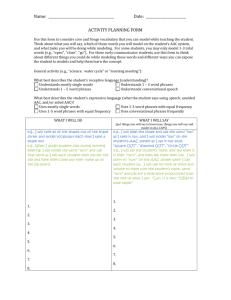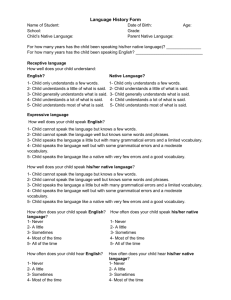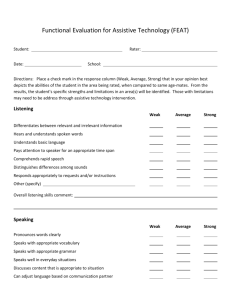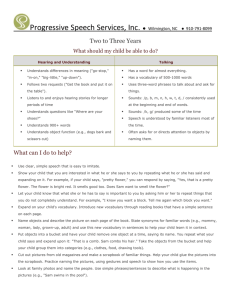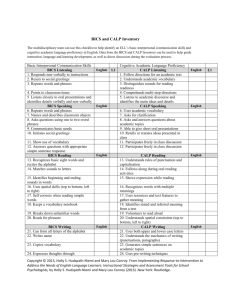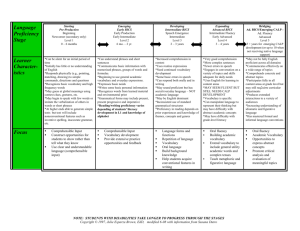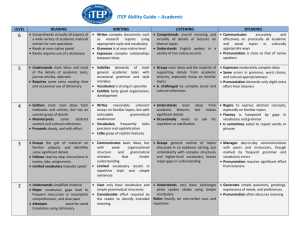EL ParaProfessional Handbook
advertisement
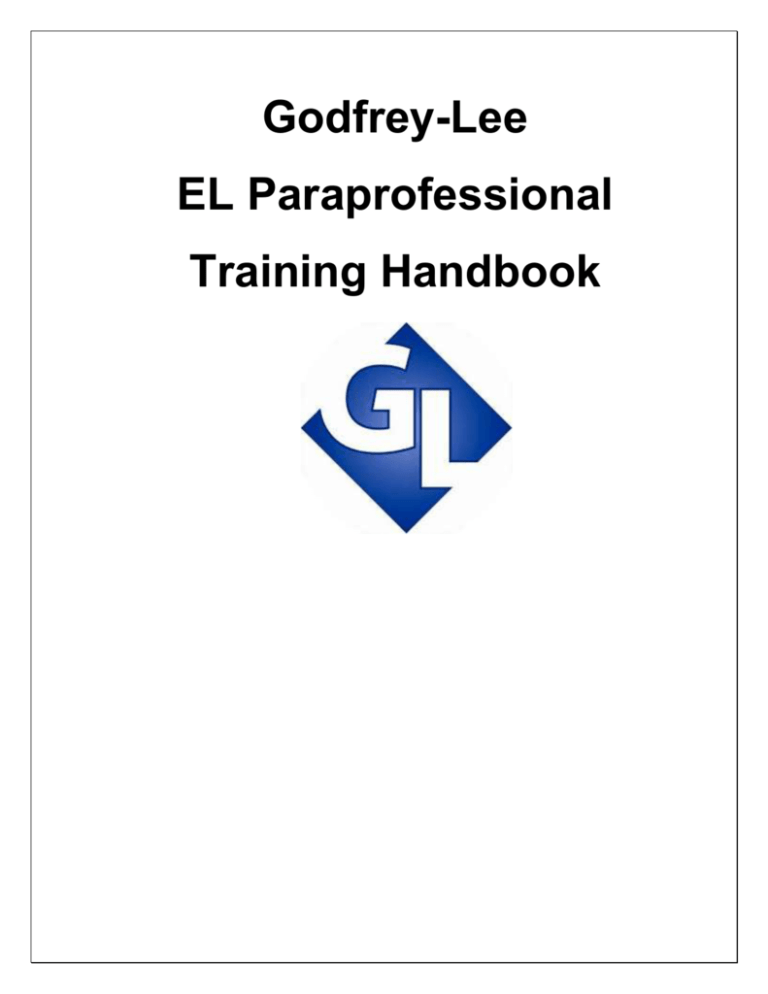
Godfrey-Lee EL Paraprofessional Training Handbook Mission Statement Our role as EL educators is to prepare each student for college and career in a 21st century global community. Our objectives are: To ensure that students gain a foundation in the four language domains (reading, writing, listening, and speaking) and become comfortable and confident in communicating with others in English. To address the spectrum of students’ learning styles by using a wide variety of language teaching methods and techniques. To provide students with constructive, specific, and detailed feedback on all areas of their language development in order for them to understand their strengths and weaknesses and how they can most effectively develop their skills. Help students navigate and adapt to life at Godfrey-Lee and to the rigors of the American educational system. 2 What are BICS & CALP? BICS= Basic Interpersonal Communication Skills Involves using language for social, face-to-face and every day situations. Highly contextualized and provides lots of clues for comprehension. Takes 0-2 years to acquire Examples: Hi, how’s it going? Can I have a bathroom pass? Want to be my partner? CALP= Cognitive Academic Language Proficiency Involves language skills and functions of an academic or cognitive nature. Language needed to accomplish academic tasks. Takes about 7-10 years to acquire. Examples: During Civil War times, most businessmen in the north made profits from industry. The sum of the squares of the legs of a right triangle is equal to the square of the hypotenuse. Can you explain the second phase of meiosis? 3 WIDA Language Levels Level 1- Entering Students at this level do not understand or speak English with the exception of a few isolated words or expressions. Level 2- Emerging The student understands and speaks conversational and academic English with hesitancy and difficulty. The student understands parts of lessons and simple directions. Level 3- Developing The student understands and speaks conversational and academic English with decreasing hesitancy and difficulty. The student’s English literacy skills allow the student to demonstrate academic knowledge in content areas with assistance. Level 4- Expanding The student understands and speaks conversational English without apparent difficulty, but understands and speaks academic English with some hesitancy. The student continues to acquire reading and writing skills in content areas needed to achieve grade level expectations with assistance. 4 WIDA Can-Do Descriptors Language Domain Level 1 Entering Level 2 Emerging Level 3 Developing Level 4 Expanding Level 5 Bridging Listening ● Point to stated pictures, words, phrases ● Follow one-step oral directions ● Match oral statements to objects, figures, or illustrations ● Sort pictures, objects according to oral directions ● Follow twostep oral directions ● Match information from oral descriptions to objects, illustrations ● Locate, select, order information from oral descriptions ● Follow multi-step oral directions ● Categorize or sequence oral information using pictures, objects ● Compare and contrast functions or relationships from oral information ● Analyze and apply oral information ● Identify cause and effect from oral discourse ● Draw conclusions or infer from oral information ● Construct models based on oral discourse ● Make connections between ideas based on oral discourse Speaking ● Name objects, people, pictures ● Answer wh(who, what, when) or choice questions ● Ask wh- or choice questions ● Describe pictures, events, objects, people ● Restate facts or statements ● Formulate hypotheses, make predictions ● Describe processes, procedures ● Retell stories or events ● Discuss stories, issues, concepts ● Give speeches, oral reports ● Offer creative solutions to issues, problems ● Engage in debates ● Explain phenomena, give examples, and justify responses ● Express and defend points of view Reading ● Match icons and symbols to words, phrases , or environmental print ● Identify concepts about print and text features ● Locate and classify information ● Identify facts and explicit messages ● Select language patterns associated with facts ● Sequence pictures, events, processes ● Identify main ideas ● Use context clues to determine meaning of words ● Interpret information or data ● Find details that support main ideas ● Identify word families, figures of speech ● Glean information from multiple sources ● Draw conclusions or infer from explicit and implicit text Writing ● Draw in response to oral directions ● Label objects, pictures, diagrams ● Produce icons, symbols, words, to convey messages ● Make lists ● Produce drawings, phrases, short sentences, notes ● Give information requested from oral or written directions ● Produce barebones expository or narrative texts. ● Compare/contrast information ● Describe events, people, processes, procedures ● Summarize information from graphic or notes ● Edit and revise writing ● Create original ideas or detailed responses ● Apply information to new contexts ● React to multiple genres and discourses ● Author multiple forms of writing 5 EL Para Classroom Support Recommendations Before Instruction During Instruction After Instruction During Assessments Assist students with developing an organizational system for academic success. Encourage the use and acquisition of English. Encourage students to review the teacher’s directions for assignments. The purpose of assessments can be two-fold: Monitor that EL students are coming to class prepared with pencils, folders, binders, agendas, assignments, etc. Familiarize yourself with the proficiency levels of the EL students in the classrooms to which you are assigned. Encourage students to stay involved and participate during class. Avoid over use of translations. Try to use simplified English and gestures or images when possible. Review teacher’s directions in English first. Recognize the distinction between the support required in content-area classes versus EL classes. Utilize a variety of supporting techniques to accommodate the needs of EL students. If possible, clarify concepts and model examples. Communicate to teacher areas of struggle and concern. Remember homework is practice, giving students the correct answers does not benefit them in the long run. 1. A check for understanding to guide further teaching 2. A time for students to show what they know and are able to do Assessment is not a time for additional instruction. To maintain the integrity of an assessment, don’t provide clues and/or answers. It would be appropriate to assist with unknown vocabulary words that are not related to the content being tested. 6 Qualities of Highly-Effective EL Paraprofessionals Models the behavior expected of students Comes prepared Teaches and models organizational skills Keeps accurate records of all worksheets, notes, and test dates. Knowledgeable of SIOP/EL Strategies and provides feedback to classroom teacher when asked. Participates in classroom activities Learns and knows classroom material Supports the classroom teacher by speaking with the teacher privately at a later time when issues or conflicts arise. Assists with discipline in a non-disruptive manner. Circulates around the classroom Allows students to develop independence, and encourages interaction with fellow students and the teacher. Listens carefully to students and is observant of body language to determine when extra support is needed. Develop relationships. Learn about the home countries of the students. Have high expectations for students. Demonstrate appreciation for diversity. 7 What Paraprofessionals Should Avoid Interrupting instruction Correcting teacher Providing answers to students Making assumptions about students Engaging in side conversations during instruction Translating too much “Tattling” on students 8 EL Support Strategies & Tips 1. Simplifying Text Reduce the grammatical complexity, while keeping all essential information. Shorten the sentences. Change the verb tenses to simple present, present progressive, or past tenses. Change the passive voice to the active voice. Delete unessential information-but retain key vocabulary! 2. Highlighted Text Teachers and/or paraprofessionals preview text to be read by the students and highlight Key Terms Concepts Summaries Other Important Information 3. Sentence Frames & Starters Sentence frames provide an opportunity for students to use key vocabulary while providing a structure that may be higher than what they could produce on their own. For example, if students are to compare two ocean creatures, they might say something like "Whales have lungs, but fish have gills." In the preceding sentence, the simple frame is "______ have ________, but _______ have _______. To increase the complexity of the sentence, we can change the frame to incorporate a different structure and higher-level academic terms. Note how the following examples increase the level of language used: ___________ have ___________, however ____________ have _______________. Whereas __________have ___________, _________have ______________. Despite the fact that _____________ have _____________, _________ have ____________. 9 Similar to sentence frames, sentence starters provide a partial frame for students to begin their sentence or idea. However, sentence starters only begin the idea, and students must complete the idea from there. For example, students sequencing a series of events might use the following sentence starters in their oral or written summaries: The first thing that happened was ... After that ... The following important event was ... Earlier in the story ... Immediately following that ... 4. Cognates Provide EL students with a list of words related in meaning and form to a word in another language; also by roots; include English word, native language word & meaning. Here is a link to a helpful English to Spanish Cognate chart: http://www.colorincolorado.org/pdfs/articles/cognates.pdf 5. Building Background Show two pictures- one that represents the content concept and one that represents something they might be familiar with- and have them compare and contrast them. Make explicit links for students. Be familiar with their experiences and make connections for them. Have students brainstorm what they now about a certain topic before teaching a content concept. Ask specific questions to provide students with opportunities to make their own connections. 10 6. Other Tips for Teaching ELs Utilize visuals (real-life objects, photographs, drawings) Use gestures for added emphasis Adjust your speech: Speak slowly; enunciate; use longer natural pauses; repeat words or phrases Allow for sufficient response time Model for students Simplify Complex Directions Indicate pages numbers in text where answers to questions can be found 11 EL Vocabulary Instruction Key Vocabulary for English Learners Academic Vocabulary Content Words Examples Graph, axis, y-intercept Process or Function Words Locate, determine, identify Words and word parts (i.e., affixes, roots) Graph (Related words: photograph, that teach English structure geography, pictograph) Multiple Meaning Words Table, multiple, difference Connectives And, but, because Research-Based Tips for Vocabulary Instruction: Direct instruction of words (provide student-friendly definition) Presenting the word in context. Visual support (pictures, definition in glossary) Translation of word. Using the words in the context of the lesson. Student interaction with words (activities and questions that make students use the words) Student internalization of definitions (retelling the definitions in their own words) 12 13
